Coniferous plants – the personification of beauty and nobility. They make the territory on which they grow, uniquely attractive, and allow it to remain so at any time.
Thanks to the huge varietal variety decorative coniferous plants ceased to be a privilege of spacious parks and settled on the lands of modest household plots. Which of them managed to win the greatest popularity among gardeners and for what the representatives of coniferous landscape designers like and we try to understand this article.
Why choose coniferous plants for the garden
Why is it today increasingly prefer to see conifers in the landscape design of small plots? There are many reasons for this. First of all, it is the invariable aesthetics of evergreens. They are beautiful in the sunlight, and in snowdrifts. Plants are not pretentious. They do not need any special conditions for growth. They can easily be entered into any landscape compositions.

Coniferous plants easily fit into any landscape composition
The presence of even low-grown coniferous plants will create a soft microclimate on the site. Their higher relatives know how to absorb noise and dust. Coniferous plantations are well protected against gusts of wind. Add to this the high performance of coniferous oxygen plus the allocation of super-beneficial to human health phytoncides and the question of whether or not to be in the landscape of your cottage to their representatives will be decided automatically.
Types of coniferous plants for the garden
“The most popular for small areas are dwarf conifers”
For garden plantings, representatives of the following categories of evergreens should be selected:
- yew;

Yew coniferous plants for the garden
- cypress;
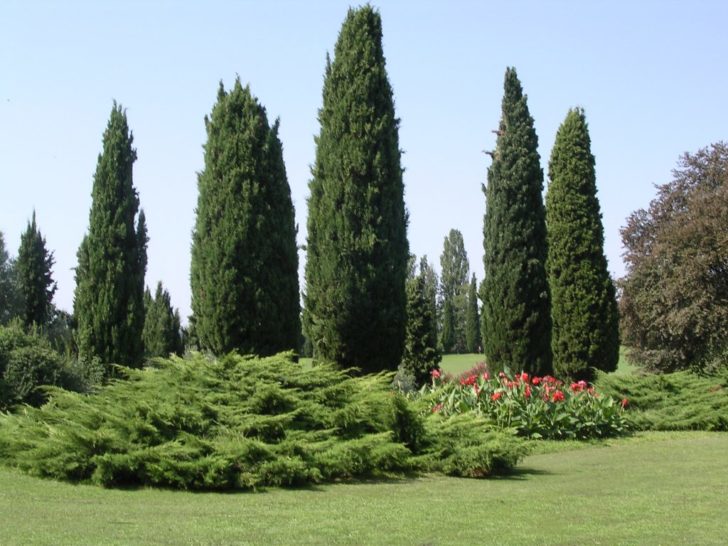
Cypress trees in the garden
- pine.
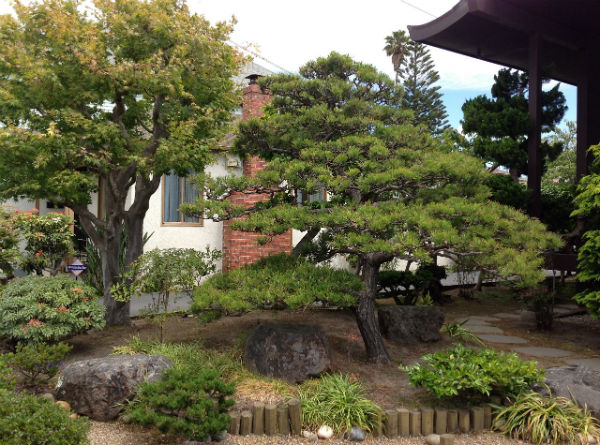
Pines for the garden
The most popular for small areas are dwarf conifers. Experts recommend looking at junipers. Photophilous conifers are ready to grow even in the sand, though on stony soils. Their representatives may have a columnar or a crowned form. These representatives of conifers saturate the air with the finest healing aroma. In the landscape design decorative coniferous plants of this kind become an ornament of stony compositions and are actively used in the creation of natural style gardens.
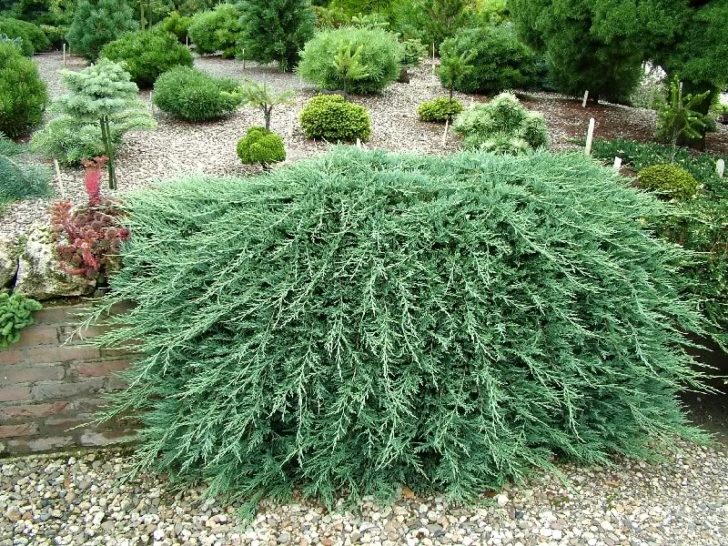
Juniper of a steaming shape
Unobtrusive thui, taking any architectural forms, are in demand in the design of the alleys and are suitable for hedges. Plants practically do not react to transplantations and are not afraid of smoky areas, so they can grow near roads.
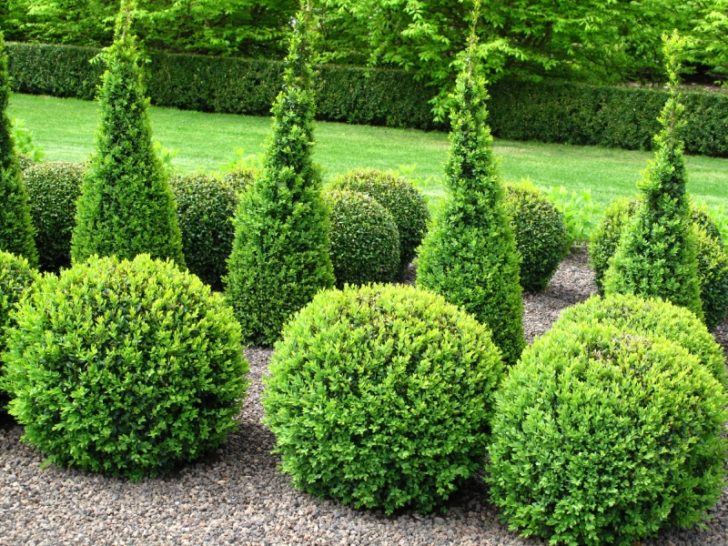
Tui with a curly hairstyle
Dwarf conifers of tuya varieties with soft scaly needles of bright green color and geometrically correctly formed crowns are planted:
- in the rock garden,
- group landing,
- on the slides.
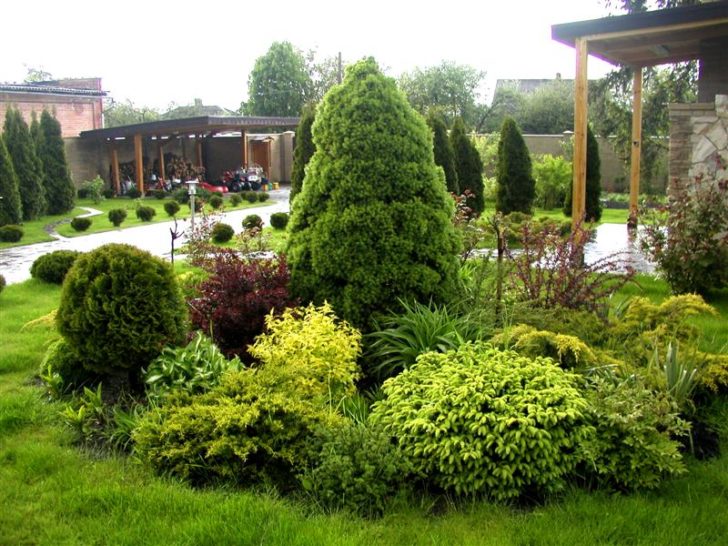
Alpinarium of coniferous plants
Representatives of larch trees are interesting in garden plantings. The low-grown coniferous plants of these species will become a worthy decoration of stony landscapes, while the tallest individuals are gathered into group plantings. They are not bad in solitary growth. Larch bribes with their longevity. Their lifetime is estimated for centuries.
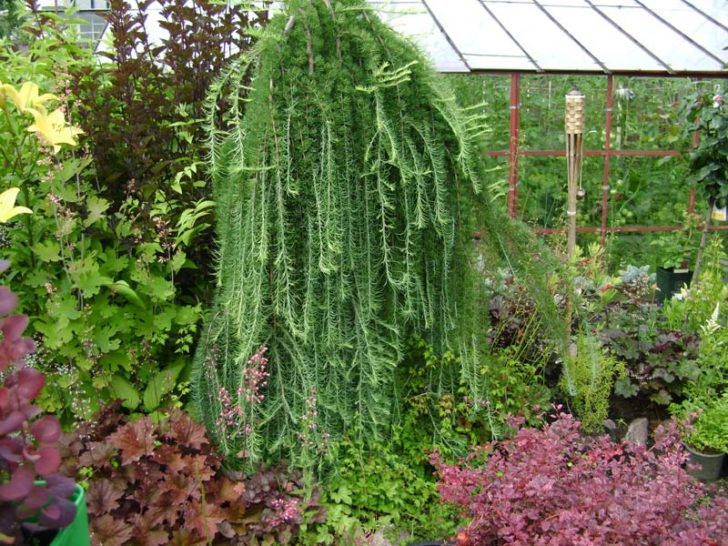
Larch in group planting
Pyramidal fir trees stand out for their healing qualities. Because of the high altitude, their representatives are mostly planted in solitary plantations.

Pyramidal fir
The most unpretentious pine and spruce are found in almost all compositions. They are pleased with the variety of colors of crowns, the growth row, readiness for topiary haircuts.
Where to
Tall decorative coniferous plants in the landscape of a small plot will assume an accentual role. They become the center of harmonious plant compositions.
Medium-sized species of coniferous plants adorn the paths, the entrance group, they work as hedges.

Live hedge from coniferous
Dwarf conifers in the landscape design of the garden are omnipresent. They are relevant in any corner and can successfully supplement any composition. They are especially good in combination with ornamental grassy.
Tall or dwarf conifers?
If you choose between tall or short tall evergreens, the latter will have a clear priority.
While they are an exact copy of a full-grown original and have all the stages of development characteristic of the variety, stunted coniferous plants do not require so much space for existence. They are more adapted to the decorative mission, so they are more harmoniously perceived in rockeries. They are valuable for growing in containers, which makes the plants mobile and allows you to move to any garden corner and even into the house. Small growth contributes to a calm winter. Covered completely with snow, coniferous plants do not freeze.
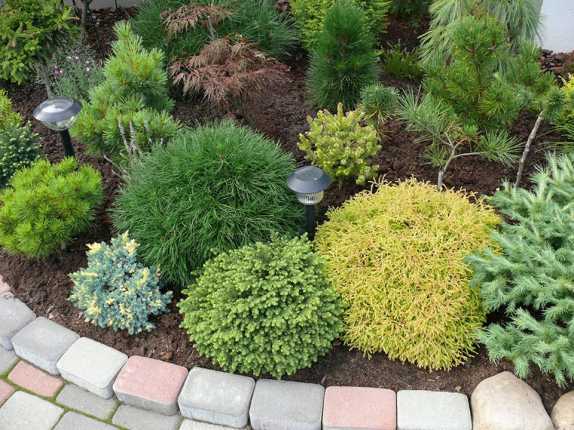
Dwarf conifers in the garden
Although some of the dwarfish are not as durable as their natural prototypes, however, the use of even such species of conifers in landscape design yields excellent results.
To prolong the life of their green friends, they need to ensure proper care, special attention, while giving the correctness of introducing additional dressings.
Rules of fertilization for coniferous plants
Generally speaking, dwarf conifers growing on garden lands do not require the introduction of a large number of nutrients. This is due to the lack of a full-fledged foliage, dropped for the winter. Trees do not need to restore the crown in the spring. They are not burdened with the process of abundant fruiting, so they need additional minerals only for forcing out annual growth, which, incidentally, is not so great for stunted coniferous plants.

Coniferous plants do not need a lot of fertilizers
What is supported by coniferous
The trees of this family are not suitable for garden nutritional mixes. Even worse, they react to organic matter such as manure and herbal infusions. Such fertilizers in coniferous plants provoke rapid growth, which often results in the death of individuals. And the problem here is not overdose, but in the chemical composition. If there is no suitable top dressing, decorative coniferous plants should not be fed at all, rather than giving them anything. Today there are no problems with the assortment of specific nutrient mixtures, however, even if the label has a label saying that this type of fertilizer is for coniferous plants, do not rush to buy it. Review the components first. Evergreen trees do not require a high content of nitrogenous compounds. They activate the growth of new shoots. The process will be so fast that new processes will not have time to mature, which will lead to their inevitable death in the cold. For the same reason, coniferous plants in the landscape design of the garden should not be given diluted mullein.
Experts insist that the optimal compounds for them are:
- overgrown compost;
- biohumus.

Biohumus is the optimal fertilizer for conifers
How to properly fertilize
To low-growing coniferous plants have not lost their decorativeness, it is enough for them to give fertilizing only twice per summer. The first portion is made during the period of activity of growth points, the second – in the last days of August. Later application of the last portion of fertilizer for coniferous plants is prohibited. To allow the trees to quickly absorb the top dressing, it is recommended to use its liquid varieties. Ready concentrates are diluted in accordance with the regulations and poured into the trunks. After watering, mulch ground is performed.

Mulching of soil for coniferous plants
If granular types of fertilizers are used for coniferous plants, then they are poured around the perimeter of the trunks and mixed with the ground by digging the last one or loosening it. Compost is added in the same way.
With excessive soil acidity, dwarf conifers should be fertilized with dolomite flour. It contains calcium and magnesium in a form easily assimilated by the root system.
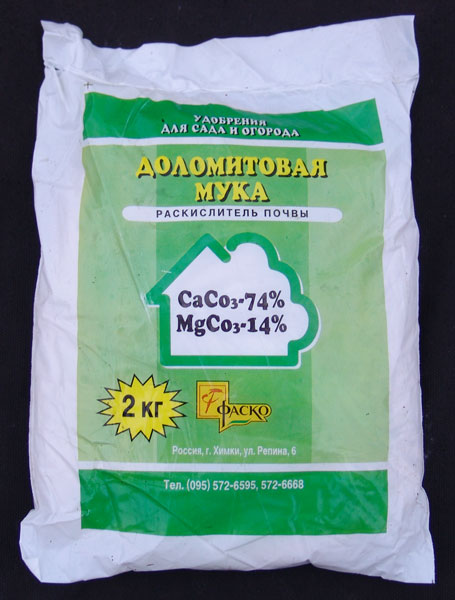
Dolomite meal will remove the excess acidity of the soil
Diseases of conifers
“To protect the planting of coniferous plants in landscape design can be the timely removal of dried specimens, and together with the root”
Indiscrimination and stamina do not save the representatives of this family from diseases. Especially the decorative coniferous plants suffer from infectious diseases provoked by fungi. On the second place there are illnesses, generated by inadequate conditions of the maintenance, in particular connected with an overabundance of a moisture. Excessive moistening and swampiness of the soil cause necrosis of needles.
Tuyam, yew, spruce very much do not like the drying of the roots, so their trunks should always be mulched. Peat, mown grass can be used for this.
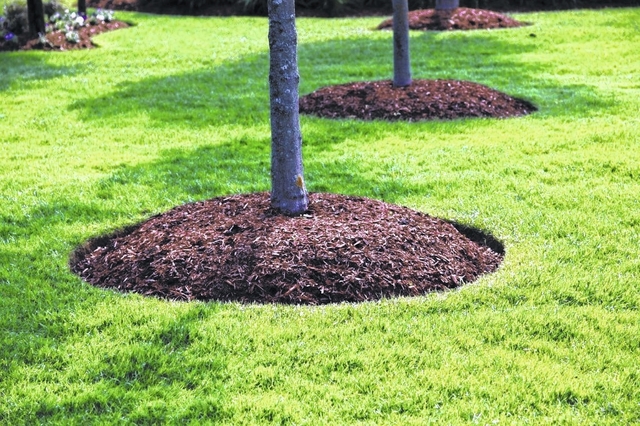
Thallus trunks should be mulched
Significant losses of dwarf conifers living in containers are due to the defeat of their roots by soil-borne fungi of the types Pythium and Rhizoctonia. To tracheocidal wilt, lesions are caused by anamorphic fungi. These parasites trigger the mycelium into the vascular bed of trees and thrombose its lumens with overgrown biomass. At first the yellowed coniferous cover falls, and then the entire plant gradually dries up.
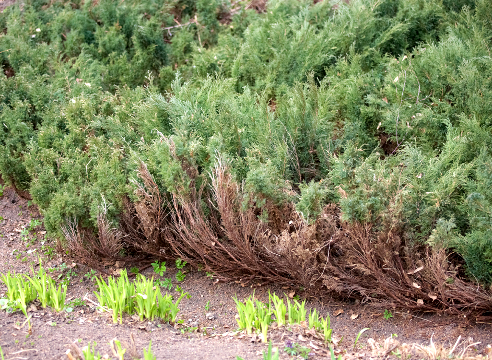
Tracheomycosis wilt of conifers
Seedlings of coniferous plants are especially vulnerable in this respect. It is almost impossible to save them. Infection has a spore-forming nature, so its pathogens are perfectly preserved even in plant remains. The disease spreads through infected soil or with infected seedlings of coniferous plants for the garden. The development of the outbreak is facilitated by boggy soil and low sunlight.
Protect the planting of coniferous plants in landscape design can be timely removal of dried specimens, together with the root. From preventive measures it is recommended to water the soil under coniferous fungicidal solutions, for example, Fundazol.

Treatment with a fungicidal solution
No less dangerous for coniferous plants are gray mold. Rotten parts of the young are already affected by rot. Disease is a scourge of thickened plantations. An alarming symptom is a gray-brown, dust-like plaque on the shoots.

Gray mold on needles
A serious problem for breeders of ornamental coniferous plants is a shute. The cause of the development of the problem is again the fungal, only ascomycetic species. At the initial stage on the needles you can see thin, like dark threads intercepting a needle, transverse lines. Spreading of the spores contributes to the increased humidity of the air in moderately warm weather.
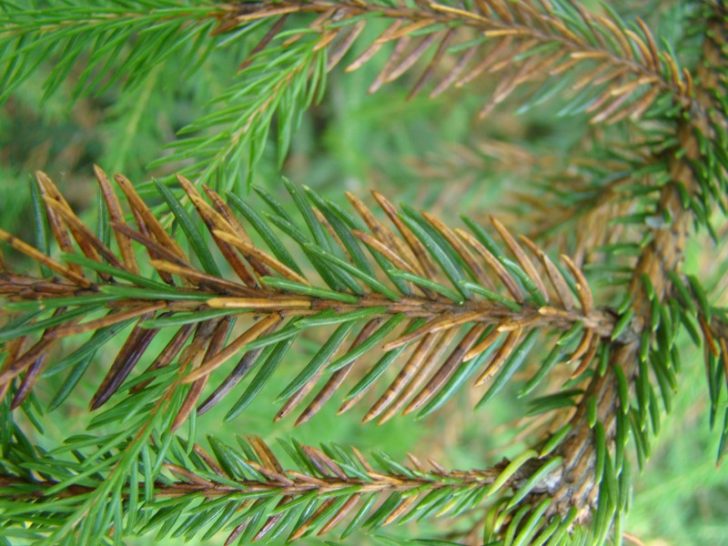
Needles infected with shute
To get rid of the shute will help timely pruning plantings and preventive spraying.
Rusty lesions of coniferous plants for the garden are also considered particularly dangerous. The causative agent of the disease is a multi-farm, so the infection is worth nothing to spread to deciduous trees and other garden flora.
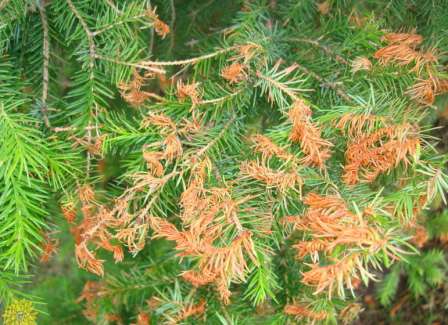
Rust damage to coniferous plants for the garden
The pine vertex is manifested by the S-shaped deformation of the shoots and the dying off of their apex. In spruce, the disease is manifested by the formation on the inner side of the scales of round, dusting, ectiopustules of a dark brown hue. The cones linger on the branches of coniferous plants for several years. The seeds produced by them are not the same. There is a curvature of shoots.

Pine Vertical
The most effective protective measure is the spatial isolation of patient specimens. Be sure to cut the damaged shoots. Increase the stability of undersized ornamental conifers to rust can be immunostimulants and specific microfertilizers.
Representatives of junipers and larches also suffer from cancerous lesions. Biatoreal type of cancer progresses in the tissues of the cortex. It dries up, changes color, crackles. As a result, the wood under bark begins to die off.
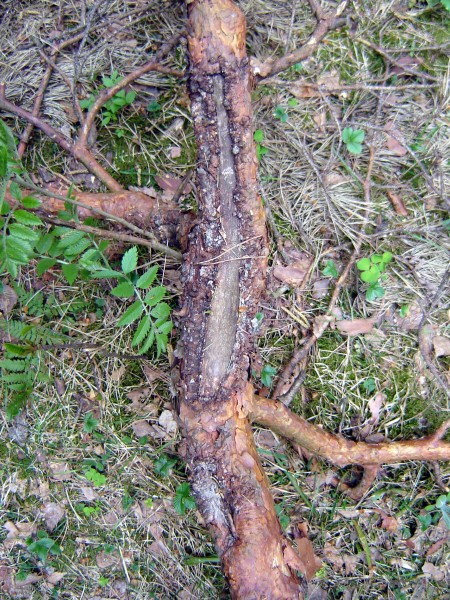
Biotorellic type of cancer progresses in the tissues of the cortex
Nectric cancer is the enemy of decorative coniferous plants of the genus of junipers. On their bark appear specific brick-red shade pads. The development of the disease is accompanied by the death of the bark, the change in the color of the needles.
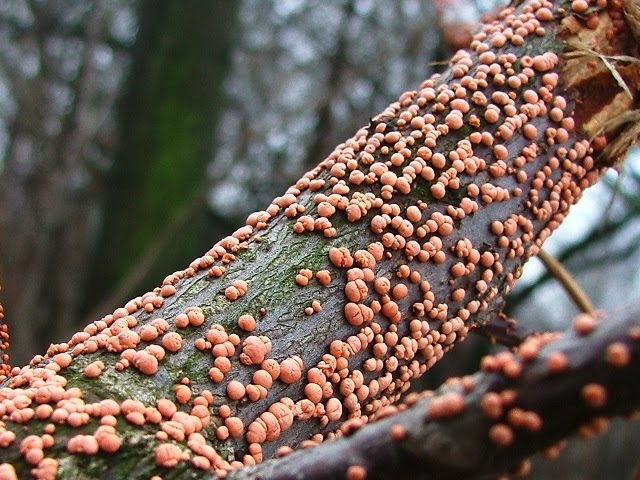
Nectric cancer in juniper
On larch, the cancer forms whole wounds, deeply corroding the trunks. The height of the disease falls on a period of rest.
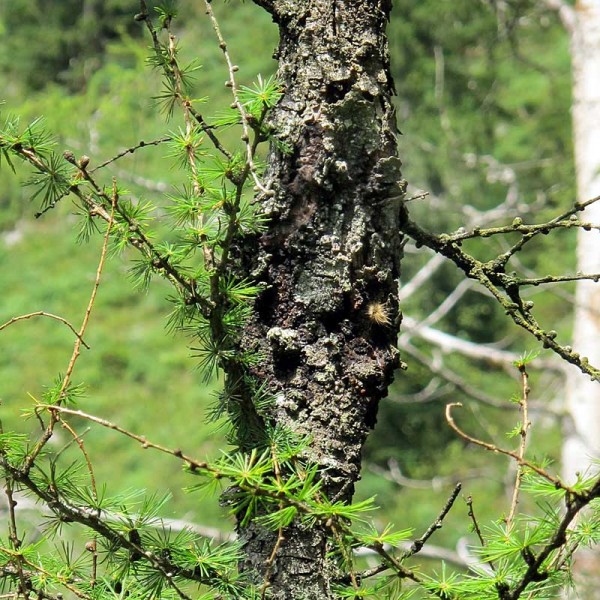
Larch, affected by cancer
In medical measures, cleaning of wounds and affected areas, followed by treatment of plots with putty. In the absence of garden varnish, it is possible to use paint with a drying oil base. Protection from diseases for coniferous plants will be spring-autumn spraying plantings Bordeaux mixture.
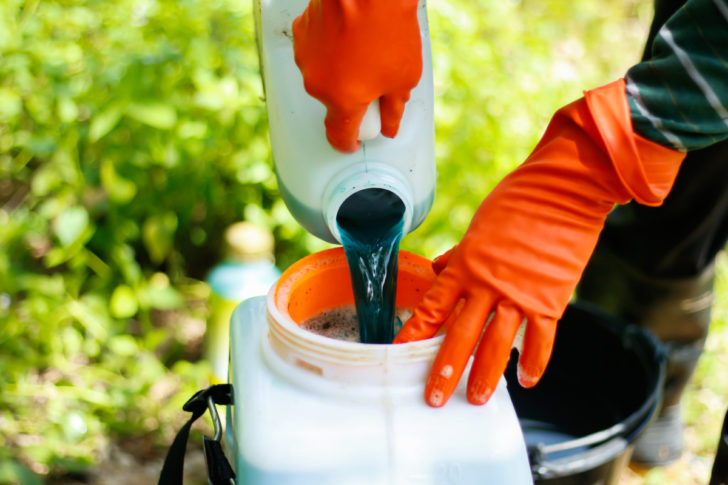
Spring-autumn spraying will protect conifers from diseases
Conclusion
Coniferous plants in the decor of the garden landscape – it’s fine, but you need to understand that their healthy plantings that give a systematic increase will look spectacular. Do not be lazy to show minimal concern for your prickly pets, and they will certainly thank you for every bit of attention.
Photo Gallery – coniferous plants for the garden
Video
Author: Mikhail Bond

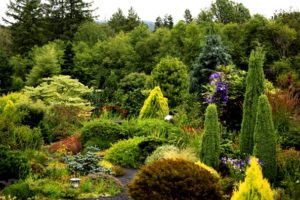
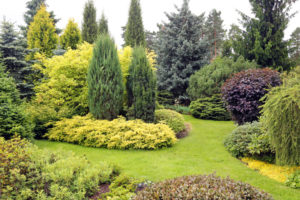
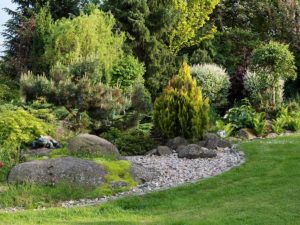
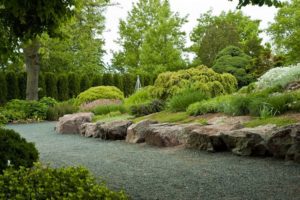
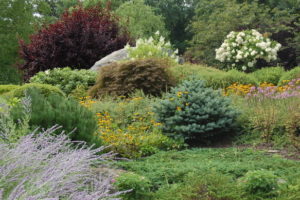
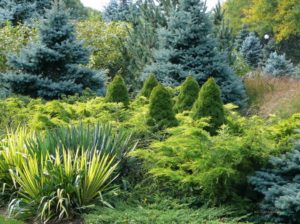




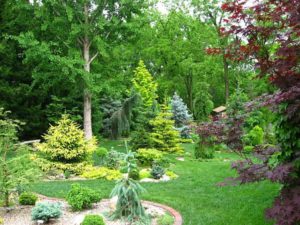
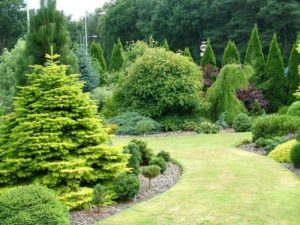
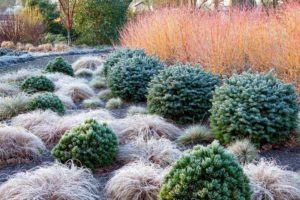
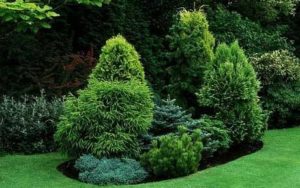
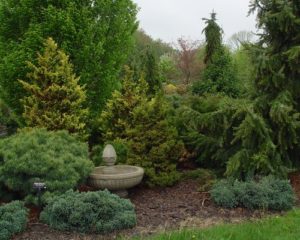

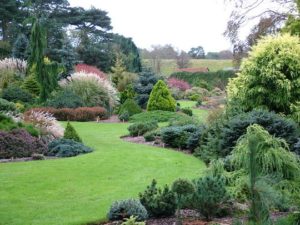
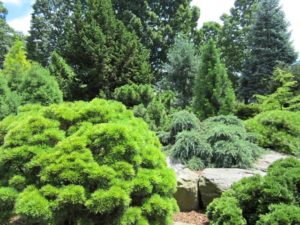
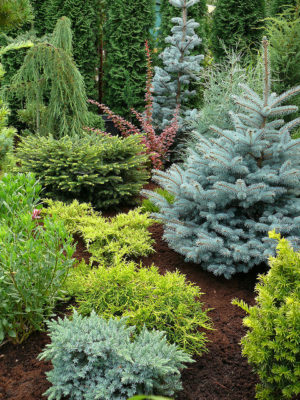
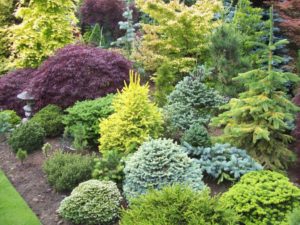
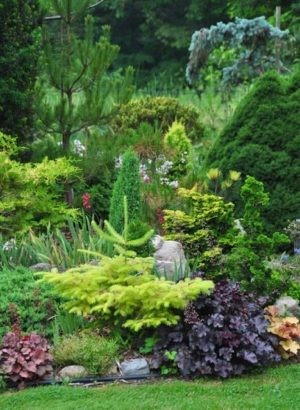

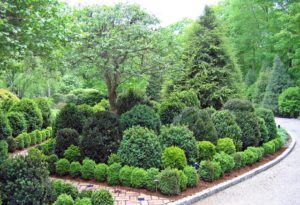
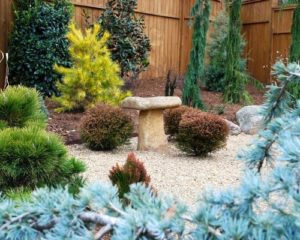
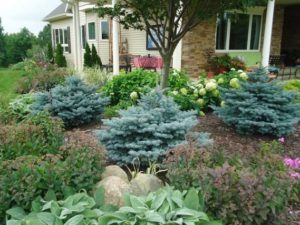
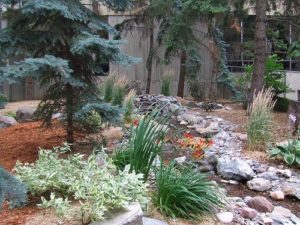

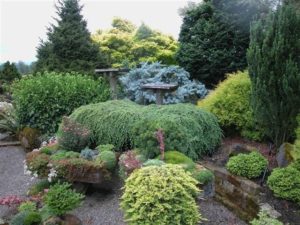
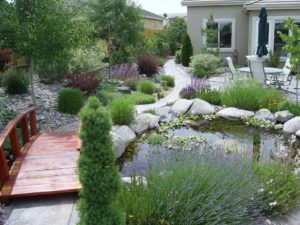
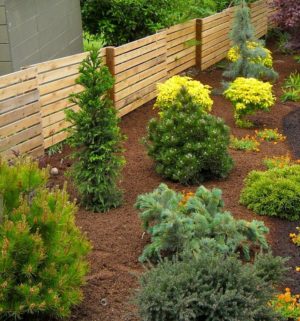
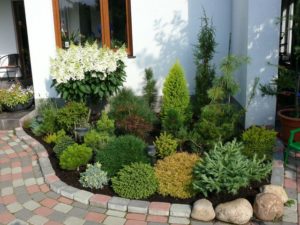


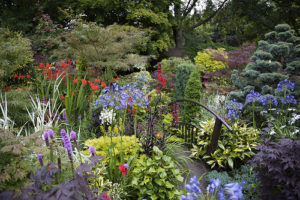
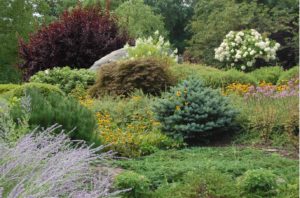
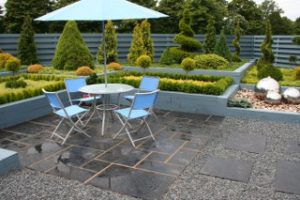
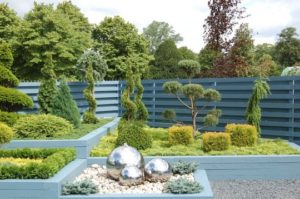
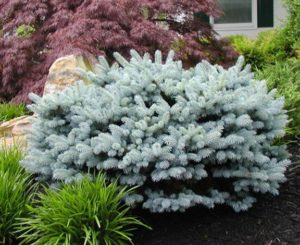
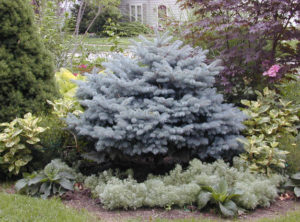
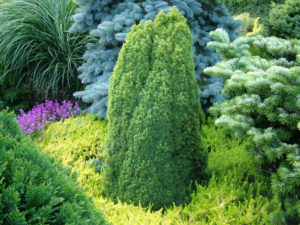

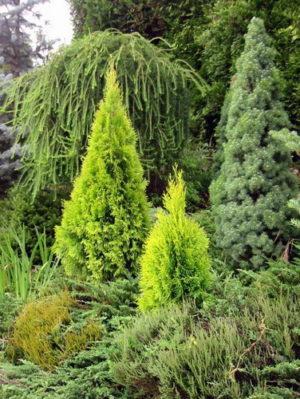
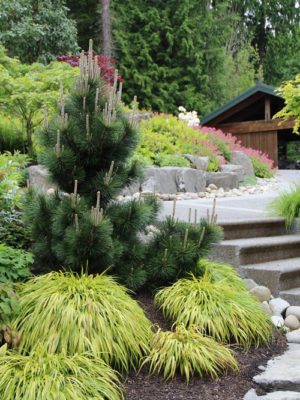
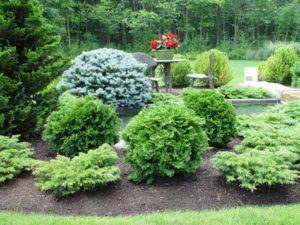
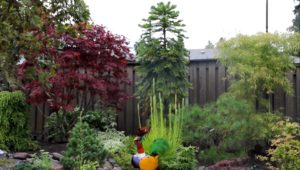
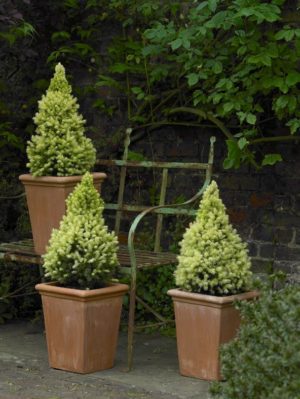

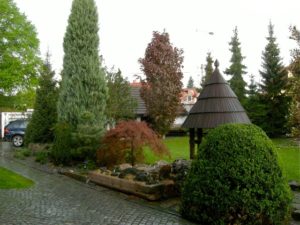
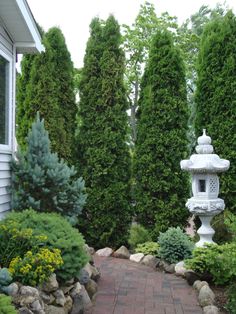
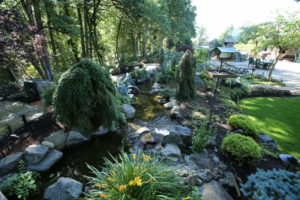
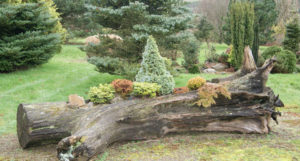
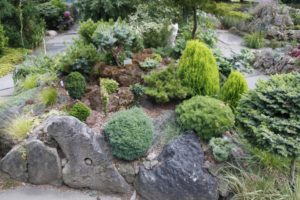
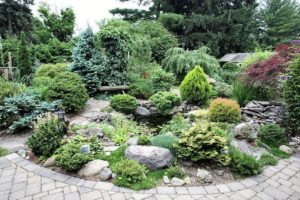


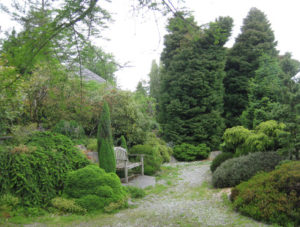
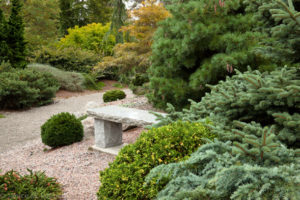
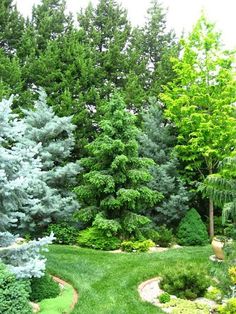
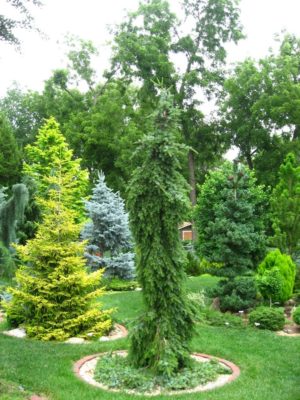
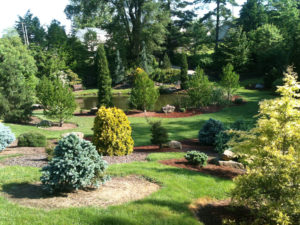
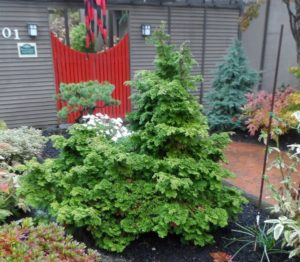


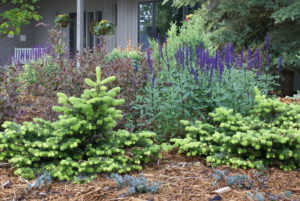

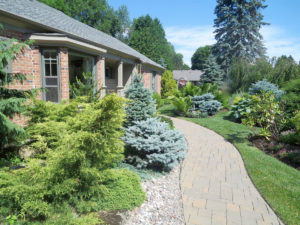
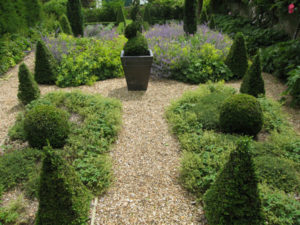
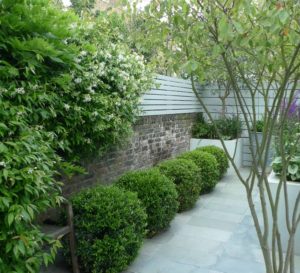

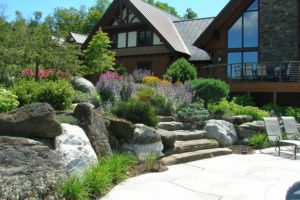
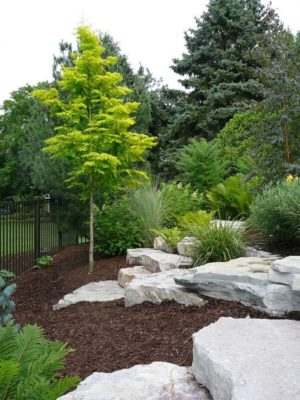
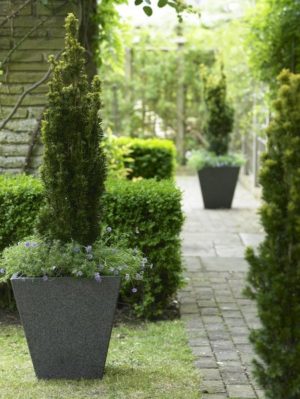
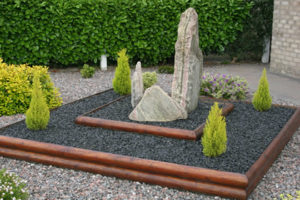

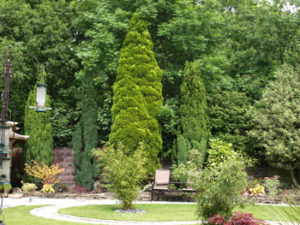
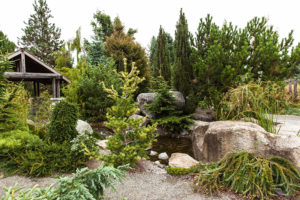
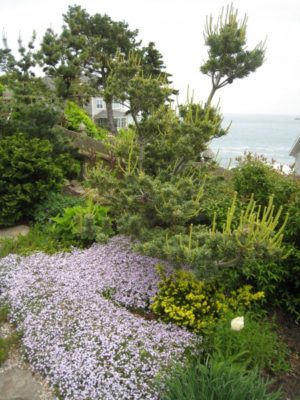
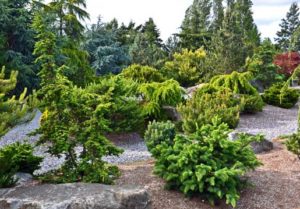
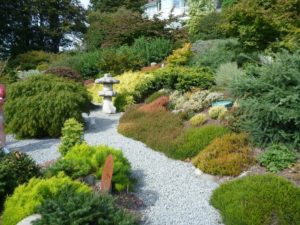

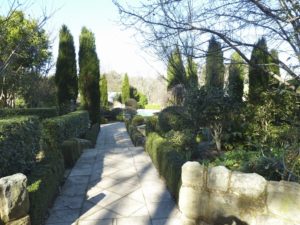
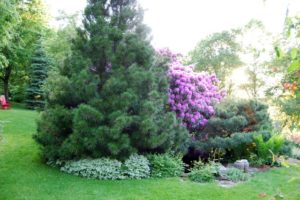
05.05.2023 @ 18:58
oniferous plants – la personificación de la belleza y la nobleza. Hacen que el territorio en el que crecen sea único y atractivo en cualquier momento. Gracias a la gran variedad de especies, las plantas coníferas decorativas dejaron de ser un privilegio de los parques espaciosos y se establecieron en los terrenos de modestas parcelas. En este artículo, intentamos entender cuál de ellas ha logrado ganar la mayor popularidad entre los jardineros y por qué a los representantes de los diseñadores de paisajes coníferos les gusta.
¿Por qué elegir plantas coníferas para el jardín? Hoy en día, cada vez más personas prefieren ver coníferas en el diseño del paisaje de pequeñas parcelas. Hay muchas razones para esto. En primer lugar, es la estética invariable de los siempreverdes. Son hermosos bajo la luz del sol y en las nevadas. Las plantas no son pretenciosas y no necesitan condiciones especiales para crecer. Se pueden incorporar fácilmente en cualquier composición de paisaje.
Las plantas coníferas se adaptan fácilmente a cualquier composición de paisaje. La presencia de plantas coníferas de bajo crecimiento creará un microclima suave en el sitio. Sus parientes más altos saben cómo absorber el ruido y el polvo. Las plantaciones coníferas están bien protegidas contra las ráfagas de viento. Añade a esto el alto rendimiento de oxígeno conífero y la emisión de fitoncidas súper beneficiosos para la salud humana, y la pregunta de si estar o no en el paisaje de tu casa de campo a sus representantes se decidirá automáticamente.
Tipos de plantas coníferas para el jardín. “Los más populares para las áreas pequeñas son los coníferas enanos”. Para las plantaciones de jardín, se deben seleccionar representantes de las siguientes categorías de siempreverdes: tejo, ciprés y pino. Los más populares para las áreas pequeñas son los coníferas enanos. Los expertos recomiendan mir